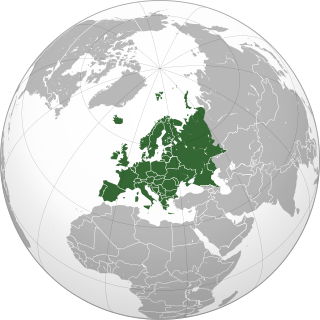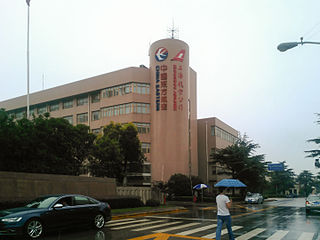
Anatolia is a large peninsula in Western Asia and the westernmost protrusion of the Asian continent. It makes up the majority of modern-day Turkey. The region is bounded by the Turkish Straits to the northwest, the Black Sea to the north, the Armenian Highlands to the east, the Mediterranean Sea to the south, and the Aegean Sea to the west. The Sea of Marmara forms a connection between the Black and Aegean seas through the Bosporus and Dardanelles straits and separates Anatolia from Thrace on the Balkan peninsula of Southeast Europe.

Europe is a continent located entirely in the Northern Hemisphere and mostly in the Eastern Hemisphere. It comprises the westernmost part of Eurasia and is bordered by the Arctic Ocean to the north, the Atlantic Ocean to the west, the Mediterranean Sea to the south, and Asia to the east. Europe is commonly considered to be separated from Asia by the watershed of the Ural Mountains, the Ural River, the Caspian Sea, the Greater Caucasus, the Black Sea, and the waterways of the Turkish Straits. Although some of this border is over land, Europe is generally accorded the status of a full continent because of its great physical size and the weight of history and tradition.

The Eastern Orthodox Church, officially the Orthodox Catholic Church, is the second-largest Christian church, with approximately 220 million baptised members. It operates as a communion of autocephalous churches, each governed by its bishops in local synods. Roughly half of Eastern Orthodox Christians live in the territory of the former Soviet Union, most of those living in Russia. The church has no central doctrinal or governmental authority analogous to the bishop of Rome, but the ecumenical patriarch of Constantinople is recognised by all as primus inter pares of the bishops. As one of the oldest surviving religious institutions in the world, the Eastern Orthodox Church has played a prominent role in the history and culture of Eastern and Southeastern Europe, the Caucasus, and the Near East.

The Levant is an approximate historical geographical term referring to a large area in the Eastern Mediterranean region of Western Asia. In its narrowest sense, it is equivalent to the historical region of Syria, which included present-day Syria, Lebanon, Jordan, Israel, Palestine and most of Turkey south-east of the middle Euphrates. In its widest historical sense, the Levant included all of the Eastern Mediterranean with its islands; that is, it included all of the countries along the Eastern Mediterranean shores, extending from Greece to Cyrenaica in eastern Libya.

The Mediterranean Sea is a sea connected to the Atlantic Ocean, surrounded by the Mediterranean Basin and almost completely enclosed by land: on the north by Western and Southern Europe and Anatolia, on the south by North Africa, and on the east by the Levant. Although the sea is sometimes considered a part of the Atlantic Ocean, it is usually referred to as a separate body of water. Geological evidence indicates that around 5.9 million years ago, the Mediterranean was cut off from the Atlantic and was partly or completely desiccated over a period of some 600,000 years during the Messinian salinity crisis before being refilled by the Zanclean flood about 5.3 million years ago.

The Middle East is a transcontinental region in Afro-Eurasia which generally includes Western Asia, all of Egypt, and Turkey. The term has come into wider usage as a replacement of the term Near East beginning in the early 20th century. The broader concept of the "Greater Middle East" also includes the Maghreb, Sudan, Djibouti, Somalia, the Comoros, Afghanistan, Pakistan, and sometimes Transcaucasia and Central Asia into the region. The term "Middle East" has led to some confusion over its changing definitions.

Western Europe is the region of Europe farthest from Asia, with the countries and territories included varying depending on context.

Eastern Europe is the region of the European continent between Western Europe and Asia. There is no consistent definition of the precise area it covers, partly because the term has a wide range of geopolitical, geographical, ethnic, cultural, and socioeconomic connotations. There are "almost as many definitions of Eastern Europe as there are scholars of the region". A related United Nations paper adds that "every assessment of spatial identities is essentially a social and cultural construct". One definition describes Eastern Europe as a cultural entity: the region lying in Europe with the main characteristics consisting of Greek, Byzantine, Slavic, Eastern Orthodox, and some Ottoman cultural influences. Another definition was created during the Cold War and used more or less synonymously with the term Eastern Bloc. A similar definition names the formerly communist European states outside the Soviet Union as Eastern Europe. Most historians and social scientists view such definitions as outdated or relegated, but they are still sometimes used for statistical purposes.

Western Christianity is one of two sub-divisions of Christianity. Western Christianity is composed of the Latin Church and Protestantism, together with their offshoots such as Independent Catholicism and Restorationism.

Eastern Christianity comprises Christian traditions and church families that originally developed during classical and late antiquity in the Middle East, Egypt, Northeast Africa, Eastern Europe, Southeastern Europe, Asia Minor, the Malabar coast of southern India, and parts of the Far East. The term does not describe a single communion or religious denomination. Major Eastern Christian bodies include the Eastern Orthodox Church, the Oriental Orthodox Churches, the Eastern Catholic Churches, Protestant Eastern Christian churches who are Protestant in theology but Eastern Christian in cultural practice, and the denominations descended from the historic Church of the East. The various Eastern churches do not normally refer to themselves as "Eastern", with the exception of the Assyrian Church of the East and the Ancient Church of the East.

The Appalachian Mountains, often called the Appalachians, are a system of mountains in eastern North America. The Appalachians first formed roughly 480 million years ago during the Ordovician Period. They once reached elevations similar to those of the Alps and the Rocky Mountains before experiencing natural erosion. The Appalachian chain is a barrier to east–west travel, as it forms a series of alternating ridgelines and valleys oriented in opposition to most highways and railroads running east–west.

The Eastern Bloc, also known as the Communist Bloc, the Socialist Bloc and the Soviet Bloc, was the group of Communist states that existed during period of the Cold War (1947–1991) in opposition to the capitalist Western Bloc. In Western Europe, the term Eastern Bloc generally referred to the USSR and its satellite states in the Comecon ; in Asia, the Soviet Bloc comprised the Mongolian People's Republic, the Socialist Republic of Vietnam, the Lao People's Democratic Republic and the People's Republic of Kampuchea, the Democratic People's Republic of Korea, and the People's Republic of China. In the Americas, the Communist Bloc included the Caribbean Republic of Cuba since 1961 and Grenada.

The Eastern Catholic Churches or Oriental Catholic Churches, also called the Eastern-rite Catholic Churches, Eastern Rite Catholicism, or simply the Eastern Churches and in some historical cases referred to as Uniates, are twenty-three Eastern Christian sui iuris (autonomous) particular churches of the Catholic Church, in full communion with the pope in Rome. Although they are distinct from the Roman Catholic Church, they are all in full communion with it and with each other.

A Christian denomination is a distinct religious body within Christianity that comprises all church congregations of the same kind, identifiable by traits such as a name, peculiar history, organization, leadership, theological doctrine, worship style and sometimes a founder. It is a secular and neutral term, generally used to denote any established Christian church. Unlike a cult or sect, a denomination is usually seen as part of the Christian religious mainstream. Most Christian denominations self-describe as Churches, whereas some newer ones tend to use the terms churches, assemblies, fellowships, etc., interchangeably. Divisions between one group and another are defined by authority and doctrine; issues such as the nature of Jesus, the authority of apostolic succession, biblical hermeneutics, theology, ecclesiology, eschatology, and papal primacy may separate one denomination from another. Groups of denominations—often sharing broadly similar beliefs, practices, and historical ties—are sometimes known as "branches of Christianity". These branches differ in many ways, especially through differences in practices and belief.

The North American Central Time Zone (CT) is a time zone in parts of Canada, the United States, Mexico, Central America, some Caribbean Islands, and part of the Eastern Pacific Ocean.

The Eastern Time Zone (ET) is a time zone encompassing part or all of 23 states in the eastern part of the United States, parts of eastern Canada, the state of Quintana Roo in Mexico, Panama in Central America, and Colombia, mainland Ecuador, Peru, and a small portion of westernmost Brazil in South America, along with certain Caribbean and Atlantic islands.

The Western Roman Empire comprises the western provinces of the Roman Empire at any time during which they were administered by a separate independent Imperial court; in particular, this term is used in historiography to describe the period from 395 to 476, where there were separate coequal courts dividing the governance of the empire in the Western and the Eastern provinces, with a distinct imperial succession in the separate courts. The terms Western Roman Empire and Eastern Roman Empire were coined in modern times to describe political entities that were de facto independent; contemporary Romans did not consider the Empire to have been split into two separate empires but viewed it as a single polity governed by two separate imperial courts as an administrative expediency. The Western Roman Empire collapsed in 476, and the Western imperial court in Ravenna was formally dissolved by Justinian in 554. The Eastern imperial court survived until 1453.

China Eastern Airlines Corporation Limited, also known as China Eastern, is an airline headquartered in the China Eastern Airlines Building, on the grounds of Shanghai Hongqiao International Airport in Changning District, Shanghai. It is one of the "Big Three" airlines of the People's Republic of China, operating international, domestic and regional routes. Its main hubs are at Shanghai Pudong International Airport and Shanghai Hongqiao International Airport.

Northeast India is the easternmost region of India representing both a geographic and political administrative division of the country. It comprises eight states – Arunachal Pradesh, Assam, Manipur, Meghalaya, Mizoram, Nagaland, Sikkim and Tripura. The region shares an international border of 5,182 kilometres (3,220 mi) with several neighbouring countries – 1,395 kilometres (867 mi) with Tibet Autonomous Region, China in the north, 1,640 kilometres (1,020 mi) with Myanmar in the east, 1,596 kilometres (992 mi) with Bangladesh in the south-west, 97 kilometres (60 mi) with Nepal in the west, and 455 kilometres (283 mi) with Bhutan in the north-west. It comprises an area of 262,230 square kilometres (101,250 sq mi), almost 8 percent of that of India.

The Catholic Church, sometimes referred to as the Roman Catholic Church, is the largest Christian church, with approximately 1.3 billion baptised Catholics worldwide as of 2018. As the world's oldest and largest continuously functioning international institution, it has played a prominent role in the history and development of Western civilization. The church consists of almost 3,500 dioceses around the world. The pope, who is the Bishop of Rome, is the chief pastor of the church, entrusted with the universal Petrine ministry of unity and correction. The church's administration, the Holy See, is in the Vatican City, a tiny enclave of Rome, of which the pope is head of state.



















